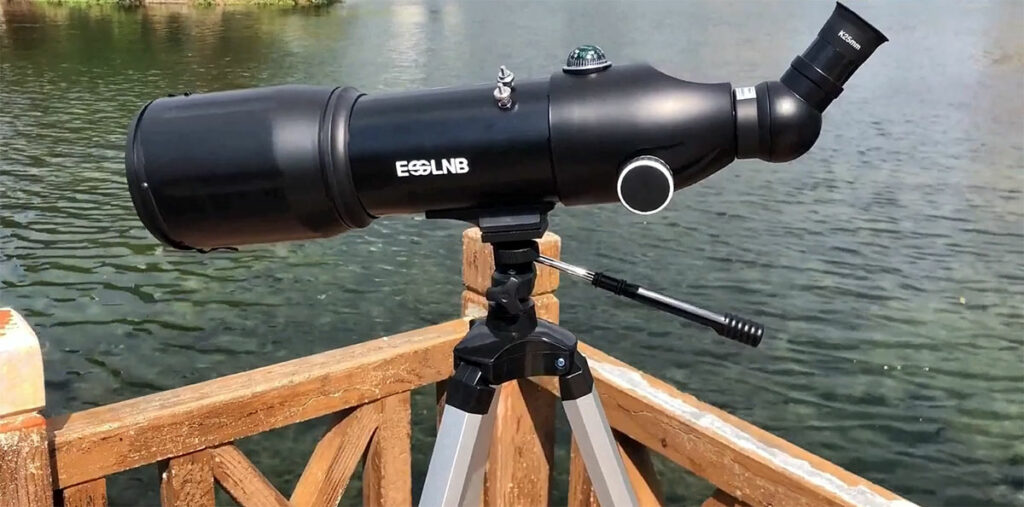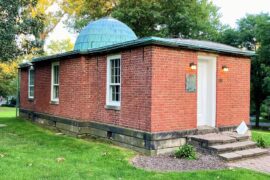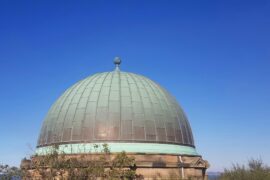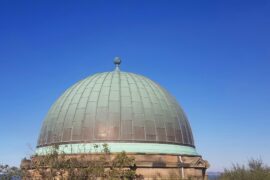It’s a good time to get started with astronomy as a hobby. There are so many quality brands competing for the hobbyist/beginner market bringing more features and better prices to the space.
ESSLNB is one of these new brands that is looking to get some recognition in the space. They are an optics company is based in Asia that was just created in 2012. They specialize in products for outdoor use like telescopes, binoculars, and spotting scopes.
Even though the company is young and its lineup is still small, focusing only on low aperture scopes, they have begun to gain the interest of some experts due to the high-quality build of the products, and innovative features.
Today we are taking a look at what is probably their most popular product, the 80mm/400mm refractor. We tested it in 3 viewing sessions under different conditions and compared it to its equivalent from one of the more known brands, the Celestron PowerSeeker 80AZS
The Verdict
Here’s the fast version of this review.
The ESSLNB 400x80mm is a decent entry-level travel telescope for its price and tech specifications. However, it doesn’t really stand out in any area when compared to other similar options in the 80mm aperture range.
This telescope is a solid purchase if it’s your first telescope, as a gift to a kid, or as a light travel telescope, however, its biggest drawback is that you might outgrow it too fast and you might find yourself wanting to upgrade too soon.
Given the choice between the ESSLNB 80/400 and a similar option like the Celestron Powerseeker 80AZS, we could only recommend this one if you find it on sale, otherwise, we’d go with the Celestron.
Here are our ratings for each specific area we reviewed.
| Optics | 8/10 |
| Build quality | 8/10 |
| Accessories | 7/10 |
| Ease of use | 8/10 |
| Portability | 9/10 |
| Price | 7/10 |
| Verdict | Buy if it’s on sale |
Technical Specifications
The ESSLNB 80/400 is a compact telescope. Its design and features are designed to make it lightweight, simple to put together, and easy to carry. Everything is more or less what you would expect from a telescope in the entry-level 70-100mm range.
| Name | ESSLNB 400x80mm |
| Telescope type | Refractor |
| Aperture | 80 mm (3.15″) |
| Focal length | 400 mm (15.75″) |
| Focal ratio | f/5 |
| Weight | 8.23 lb (3.75 Kg) |
| Finder scope | 5 x 20 |
| Eyepiece slot | 1.25″ |
| Maximum magnification | 200x |
| Included eyepieces | Kellner 9mm, Kellner 25mm |
| Tripod | 120cm, Aluminium |
| Other included accessories | Phone adapter, moon filter |
ESSLNB 80/400 In-depth Review
The 80 and 400 in the telescope’s name come from its technical specifications. It has an aperture of 80mm and a focal length of 400mm.
The aperture is the diameter of the lens a telescope uses to capture the light coming from outside. In general, you could say it’s the most important number in your telescope as it’s going to determine the limits in image quality and magnification a telescope can reach.
Entry-level telescopes go from 50mm in aperture to 130mm. The minimum aperture we recommend for a beginner’s telescope is 70mm, so the EESLNB is in a safe area if this is your first telescope.
This telescope has a refractor design. Another point in its favor. Refractor telescopes are much better than reflectors or other types of telescopes because they don’t require maintenance, they are easier to use, and they tend to last longer.
The optics in the ESSLNB 80/400 are pretty good. When compared to other telescopes with the same specs, the quality, brightness, and colors in the image remained solid. It’s not the best of the pack, but it’s far from the worst. As a beginner, you most likely will not even be able to tell the difference between an image captured by the EELNB and one from the premium brands.
The telescope is clearly designed for easy travel. It’s easy to assemble and disassemble, its light, small, and it even has a cute spherical compass at the top, which is a feature I hadn’t seen before, and while it seems like a small thing, we ended up using it more often than we thought and turned out to be quite handy when we took it into the field.
The trade off for travel telescopes generally is a low focal length and that’s the case once again here. The telescope has a focal length of 400mm. This is going to determine the maximum useful magnification the telescope can reach, which in this case is around 200x. While this number is more than good enough for planetary and deep space observing where you generally won’t be using more than 120x, it does limit its power for terrestrial and lunar observing.
One of the best features of this telescope is the inclusion of a 360-degree rotating prism diagonal. The prism diagonal is the piece where you connect the eyepiece you will use to view the image. A rotating eyepiece means that you will be able to see the image coming out of the telescope in its regular direction instead of upside down. Many beginners don’t know this when they purchase their first telescope, but the images that come out of a telescope are upside down because of the way the lenses and mirrors on the inside reflect the light. Some people end up being put off by this and even think their telescope is malfunctioning. Eventually, you get used to the images being upside down, and it’s not something that matters much when looking at space, but if you want to use it for terrestrial viewing, then you need to add an accessory to the diagonal in order to flip the image. Having a rotating prism from the start skips this step and allows you to use the telescope both ways.
The one thing we really didn’t like about the ESSLNB 80/400 is the included accessories. It comes with two Kellner eyepieces, one is 9mm and the other is 25mm. Kellners are serviceable eyepieces, but as you gain experience stargazing, you start noticing their limitations and you end up outgrowing them and having to replace them with higher quality Plossl eyepieces. We generally prefer telescopes that come with Plossls out of the box because even if they are slightly more expensive, they will last you forever, while Kellners will eventually need to be replaced and you are going to end up spending more money long-term.
The telescope also comes with a 3x Barlow lens out of the box. While this is a nice addition, a 3x Barlow might be overkill for the eyepieces it comes with. We replaced it with a generic 2x Barlow in our viewing sessions and got much better results.
Finally, it comes with a Moon filter for lunar observing, which is welcome and does save you a few bucks. It also comes with a smartphone adapter, which is almost expected from any hobbyist-grade telescope these days.
Conclusions
Who is it for?
- First time buyers
- A kid’s first telescope.
- Someone looking to get a secondary telescope specifically for traveling
Who it isn’t for?
- Experienced and advanced stargazers
- Someone who isn’t going to travel
Is it a good buy?
It’s a decent buy, but we’d only recommend it over their competitors if you can find it on sale or at a considerably lower price than those.
What are some options
- If you aren’t planning on traveling with it, and don’t mind the additional weight and length, we’d recommend you to go with a bit more focal length and try something like the PowerSeeker 80EQ
- If you want something with the exact same portable tech specs but that performs better, try the PowerSeeker 80AZS
Enjoyed this article?
Get daily 10-minute PDFs about astronomy to read before bed!
Sign up for our upcoming micro-learning service where you will learn something new about space and beyond every day while winding down.










